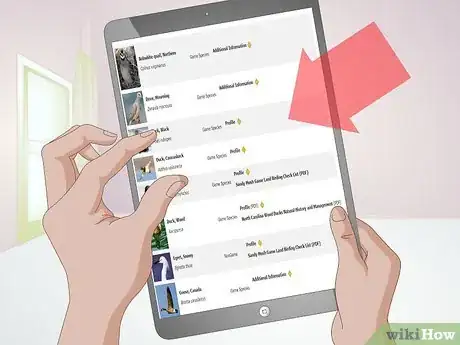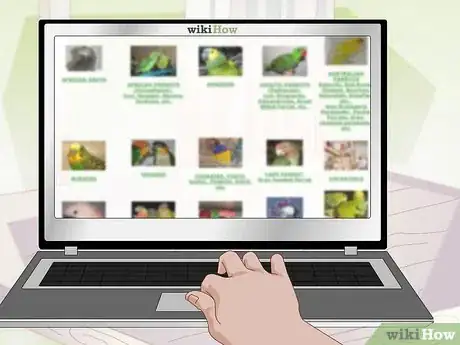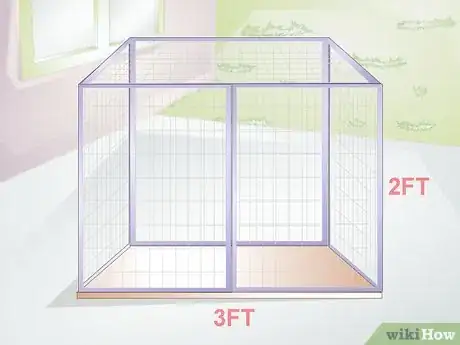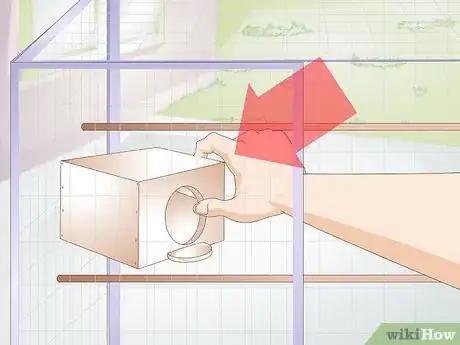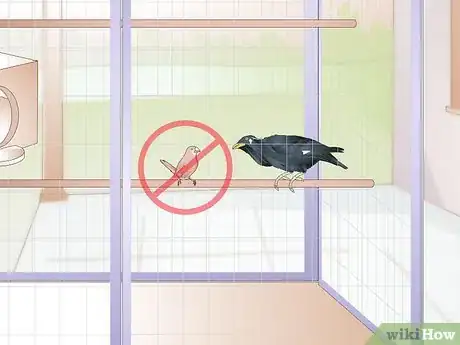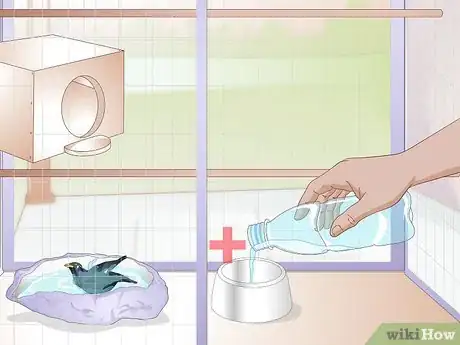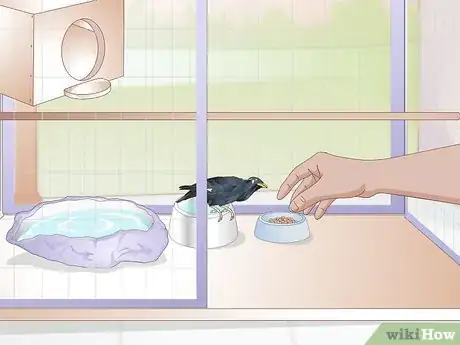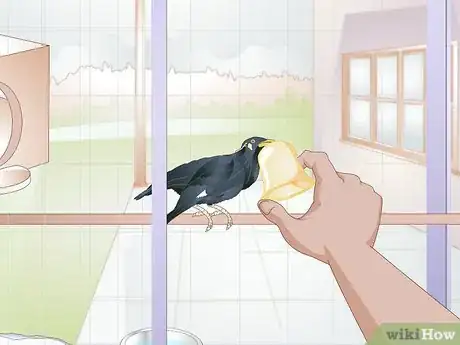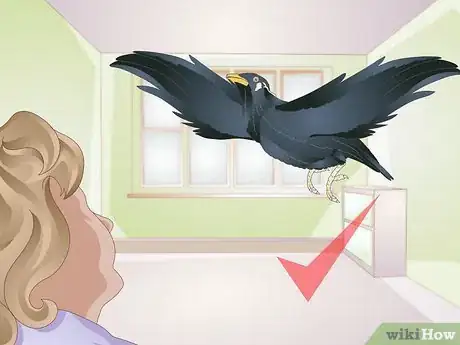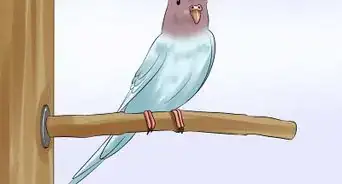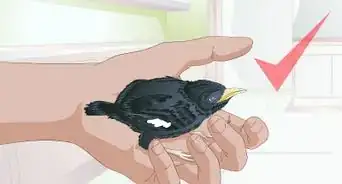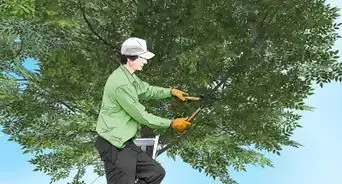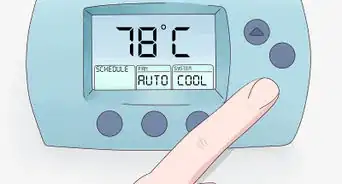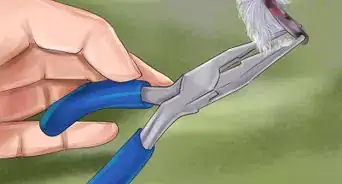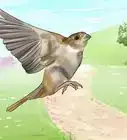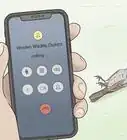This article was co-authored by Pippa Elliott, MRCVS. Dr. Elliott, BVMS, MRCVS is a veterinarian with over 30 years of experience in veterinary surgery and companion animal practice. She graduated from the University of Glasgow in 1987 with a degree in veterinary medicine and surgery. She has worked at the same animal clinic in her hometown for over 20 years.
This article has been viewed 67,205 times.
Mynah birds have long been coveted for their beautiful plumage and their penchant for mimicry. In the mynah bird family, the Hill Mynah – the Greater Indian Hill Mynah and the Java Hill Mynah – are the most common species of mynah kept as pets. They can be difficult to obtain and, once purchased, require significant care and attention. If you think that you might keep a mynah bird as a pet you will need to know how to find a bird, create a habitat for them and take care of them.
Steps
Finding a Mynah Bird
-
1Check local rules and regulations. Depending on where you live, there may be restrictions or certain licenses you will need to own and raise a mynah bird. It is important that you check with the local government body that deals with wildlife management, such as the game and parks or the fish and wildlife commission.
- This is particularly important if you are raising mynah birds to sell later on. Although you will not need a license to buy a mynah bird, you may need one if you intend to sell the bird. Check your local laws and regulations.
-
2Locate a certified exotic bird dealer. Owing to their popularity as a pet, the illegal trapping of mynah birds has significantly depleted the bird’s wild population. This has resulted in the growth of illegally caught and traded Mynah birds. In order to avoid buying an illegally caught bird, always purchase from a dealer certified with the United State Department of Agriculture’s Animal and Plant Health Inspection Service.
- You can find dealers online through various bird buying sites.
Advertisement -
3Find a mynah bird in your price range. The birds are expensive. Because of the restrictions against obtaining a mynah bird, they can cost between $500 and $1500. Consider whether you are willing to pay that much before contacting a dealer.
- Consider adopting a mynah bird. However, this option is difficult because of the bird’s rarity.
-
4Consider DNA testing. It is next to impossible to differentiate between male and female mynah birds, so you may want to find out through DNA testing. Often a dealer will have already tested the bird and will let you know their sex. You could also buy DNA testing kits online and mail a feather to the laboratory for evaluation.[1]
-
5Buy a baby mynah bird. If you wish to tame the bird yourself and teach them to talk and do tricks, you should buy a 6-8 week old bird. They tend to quit learning new words once they reach two years of age. If you don't care about that, then you could purchase an adult.
- Mynahs begin to speak at three to four months of age.
- Begin speaking to the young bird as soon as you bring them home. Start off with simple words like “hello” or “hi.”
Creating a Mynah Bird Habitat
-
1Make sure you have enough space. As mynah birds are a larger bird species, they require a lot of room. The typical dimensions of a mynah bird cage are 3-4 feet wide (90-100cm) by 2 feet tall (60cm) by 2 feet deep (60cm). Their rarity makes it hard to find an affordable cage that is specifically made for them. However, in a pinch, you can put together two parrot cages.[2]
- As mynah birds will hop around from side to side, it is best to give them lots of vertical space.
- If you are breeding a pair of mynah birds, you may want to consider purchasing an outdoor aviary.[3]
-
2Provide perches. It is important that you place multiple perches in your bird’s cage. These will help prevent foot injuries and the development of arthritis. Avoid rope perches because the brid’s toenails can get caught in them.[4]
-
3Install a nest box. If placed in their cage, a mynah bird will sleep in a nest box. The birds tend to take multiple short naps during the day and sleep all night. This will give them a dark and comfortable place to rest.[5]
- You can also cover their cage at night or provide a cardboard box for them to go inside of.
-
4Manage the light, heat and humidity. Be sure to place your bird’s cage near sunlight, but not in direct sunlight. This can lead them to get overheated. If your bird’s cage is not exposed to sunlight, you may need a light fixture designed for caged birds. Mynah birds enjoy room temperature (76 degrees Fahrenheit or 24 degrees Celsius) but can acclimate to slightly colder temperatures. Provide your mynah bird with a spritz of warm water every day to keep them comfortable.[6]
-
5Keep away from smaller birds. Mynah birds can attack them, so it is best if your bird is kept in their own cage. However, they will sometimes cohabitate with another mynah bird. This may be particularly useful if you are looking to breed a pair.
- A nesting pair of mynah birds form a strong bond and both birds share nesting duties. If you do intend to breed mynah birds, leave the breeding pair together.[7]
-
6Place the cage in a busy place. Mynah birds are extremely social and tend to enjoy human interaction. Be sure to put them in place where they can talk to multiple people and develop their language skills. They may form a strong bond with the person who cleans their cage and feeds them.
- Mynahs also have good memories and remember mistreatment. They will hold grudges and dislike people who resemble the person who mistreated them.
Taking Care of a Mynah Bird
-
1Keep a bathing dish and water bottle in the cage. Mynah birds do not need much water to drink because they get most of their moisture from their food. However, they will need to ingest some fresh water. It is also important for them to have access to water in order to take a bath. Mynah birds will take two baths a day. This will ensure that their feathers stay clean and healthy.
- Mynah birds should only be given distilled water and not tap water.
-
2Feed the bird a low iron diet. Mynah birds suffer from hemochromatosis, or an inability to store iron. Therefore, they need a diet that is low in, but not absent of, iron. You should provide them commercially produced, low iron (150 parts per million) mynah bird pellets, which you can find online or at most pet stores. Pellets should be roughly 60% of your bird’s diet.[8]
- Mynah birds also enjoy some fresh fruits (figs, oranges, papayas, apples, plums, grapes).
- They may also enjoy insects (crickets, mealworms and wax worms).
- Insects should not be more than 5% of your bird’s diet unless you are breeding birds.
-
3Give them some supplements. If your mynah bird’s diet is less than 60% pellets, you may want to consider various supplements. Your bird may develop a deficiency in certain vitamins, minerals, or amino acids.[9]
- Your bird may have a deficiency if they fail to malt during a year. A healthy mynah bird will malt twice a year, and failing to malt may be a sign of a vitamin deficiency.
- If you believe that your bird is suffering from a deficiency, talk to your veterinarian.
-
4Provide lots of toys. Because they are intelligent animals, mynah birds enjoy playing with toys. Mirrors, bells, bottle caps, and other small items can serve as toys for your mynah bird. This will keep them happy and engaged.
- Avoid rope toys because they can get caught in your bird’s tongue or toenails.
-
5Allow plenty of exercise. Mynah birds need exercise and should be allowed out of their cage daily. Before you let your bird out of their cage, make sure that you have closed all of the windows and doors, turned off any fans, covered any water, and ensured that there are not any predators around, such as house cats. Keeping you mynah bird in good shape will improve their quality of life.
- You may want to clip your birds wings. Without a clipping, mynah birds can lose their balance and have a difficult time landing. This can result in injury or death.
References
- ↑ http://www.pet-informed-veterinary-advice-online.com/bird-sexing.html
- ↑ http://www.petplace.com/article/birds/general/bird-profiles/choosing-a-mynah-bird
- ↑ http://blogs.thatpetplace.com/thatbirdblog/2008/05/10/the-natural-history-and-captive-care-of-the-hill-myna-myna-bird-indian-hill-myna-gracula-religiosa-part-2/
- ↑ http://www.petplace.com/article/birds/general/bird-profiles/choosing-a-mynah-bird
- ↑ http://www.petplace.com/article/birds/general/bird-profiles/choosing-a-mynah-bird
- ↑ http://blogs.thatpetplace.com/thatbirdblog/2008/05/10/the-natural-history-and-captive-care-of-the-hill-myna-myna-bird-indian-hill-myna-gracula-religiosa-part-2/
- ↑ http://www.petplace.com/article/birds/general/bird-profiles/choosing-a-mynah-bird
- ↑ http://blogs.thatpetplace.com/thatbirdblog/2008/05/10/the-natural-history-and-captive-care-of-the-hill-myna-myna-bird-indian-hill-myna-gracula-religiosa-part-2/
- ↑ http://www.petsworld.in/blog/a-comprehensive-feeding-guide-for-the-mynah-birds.html
About This Article
To raise a mynah bird, purchase a large cage that's 3 to 4 feet wide, 2 feet tall, and 2 feet deep. Or, you can secure 2 parrot cages together to create ample space for your bird. You’ll also need to put perches, toys, and a nest box in the cage. Additionally, keep a bathing dish and a water bottle in the cage so your bird has enough water to drink as well as keep clean with. In order to feed your bird, give it mynah bird pellets, fresh fruits, and insects. For more tips from our Veterinary co-author, including how to give your mynah bird enough exercise, keep reading!
